Xusheng Luo
Hierarchical Temporal Logic Task and Motion Planning for Multi-Robot Systems
Apr 29, 2025Abstract:Task and motion planning (TAMP) for multi-robot systems, which integrates discrete task planning with continuous motion planning, remains a challenging problem in robotics. Existing TAMP approaches often struggle to scale effectively for multi-robot systems with complex specifications, leading to infeasible solutions and prolonged computation times. This work addresses the TAMP problem in multi-robot settings where tasks are specified using expressive hierarchical temporal logic and task assignments are not pre-determined. Our approach leverages the efficiency of hierarchical temporal logic specifications for task-level planning and the optimization-based graph of convex sets method for motion-level planning, integrating them within a product graph framework. At the task level, we convert hierarchical temporal logic specifications into a single graph, embedding task allocation within its edges. At the motion level, we represent the feasible motions of multiple robots through convex sets in the configuration space, guided by a sampling-based motion planner. This formulation allows us to define the TAMP problem as a shortest path search within the product graph, where efficient convex optimization techniques can be applied. We prove that our approach is both sound and complete under mild assumptions. Additionally, we extend our framework to cooperative pick-and-place tasks involving object handovers between robots. We evaluate our method across various high-dimensional multi-robot scenarios, including simulated and real-world environments with quadrupeds, robotic arms, and automated conveyor systems. Our results show that our approach outperforms existing methods in execution time and solution optimality while effectively scaling with task complexity.
Scaling Up Natural Language Understanding for Multi-Robots Through the Lens of Hierarchy
Aug 15, 2024



Abstract:Long-horizon planning is hindered by challenges such as uncertainty accumulation, computational complexity, delayed rewards and incomplete information. This work proposes an approach to exploit the task hierarchy from human instructions to facilitate multi-robot planning. Using Large Language Models (LLMs), we propose a two-step approach to translate multi-sentence instructions into a structured language, Hierarchical Linear Temporal Logic (LTL), which serves as a formal representation for planning. Initially, LLMs transform the instructions into a hierarchical representation defined as Hierarchical Task Tree, capturing the logical and temporal relations among tasks. Following this, a domain-specific fine-tuning of LLM translates sub-tasks of each task into flat LTL formulas, aggregating them to form hierarchical LTL specifications. These specifications are then leveraged for planning using off-the-shelf planners. Our framework not only bridges the gap between instructions and algorithmic planning but also showcases the potential of LLMs in harnessing hierarchical reasoning to automate multi-robot task planning. Through evaluations in both simulation and real-world experiments involving human participants, we demonstrate that our method can handle more complex instructions compared to existing methods. The results indicate that our approach achieves higher success rates and lower costs in multi-robot task allocation and plan generation. Demos videos are available at https://youtu.be/7WOrDKxIMIs .
Certifying Robustness of Learning-Based Keypoint Detection and Pose Estimation Methods
Jul 31, 2024



Abstract:This work addresses the certification of the local robustness of vision-based two-stage 6D object pose estimation. The two-stage method for object pose estimation achieves superior accuracy by first employing deep neural network-driven keypoint regression and then applying a Perspective-n-Point (PnP) technique. Despite advancements, the certification of these methods' robustness remains scarce. This research aims to fill this gap with a focus on their local robustness on the system level--the capacity to maintain robust estimations amidst semantic input perturbations. The core idea is to transform the certification of local robustness into neural network verification for classification tasks. The challenge is to develop model, input, and output specifications that align with off-the-shelf verification tools. To facilitate verification, we modify the keypoint detection model by substituting nonlinear operations with those more amenable to the verification processes. Instead of injecting random noise into images, as is common, we employ a convex hull representation of images as input specifications to more accurately depict semantic perturbations. Furthermore, by conducting a sensitivity analysis, we propagate the robustness criteria from pose to keypoint accuracy, and then formulating an optimal error threshold allocation problem that allows for the setting of a maximally permissible keypoint deviation thresholds. Viewing each pixel as an individual class, these thresholds result in linear, classification-akin output specifications. Under certain conditions, we demonstrate that the main components of our certification framework are both sound and complete, and validate its effects through extensive evaluations on realistic perturbations. To our knowledge, this is the first study to certify the robustness of large-scale, keypoint-based pose estimation given images in real-world scenarios.
ModelVerification.jl: a Comprehensive Toolbox for Formally Verifying Deep Neural Networks
Jun 30, 2024
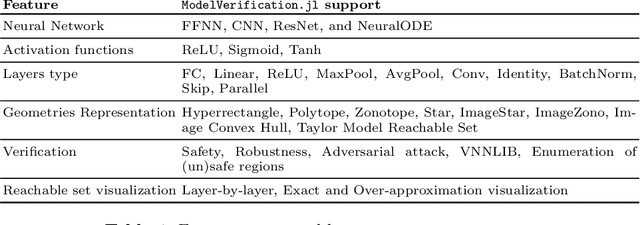
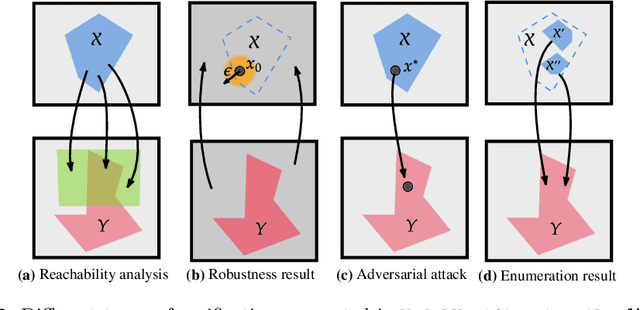
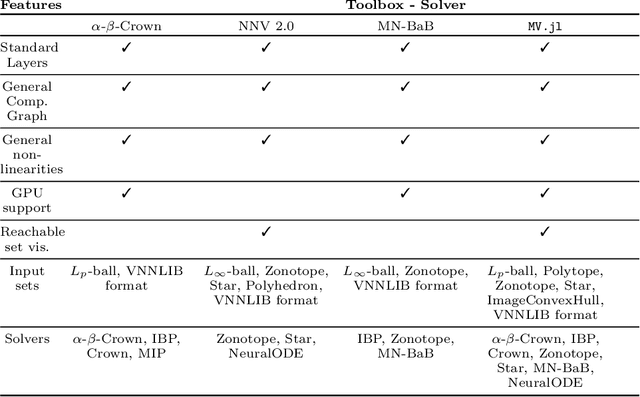
Abstract:Deep Neural Networks (DNN) are crucial in approximating nonlinear functions across diverse applications, ranging from image classification to control. Verifying specific input-output properties can be a highly challenging task due to the lack of a single, self-contained framework that allows a complete range of verification types. To this end, we present \texttt{ModelVerification.jl (MV)}, the first comprehensive, cutting-edge toolbox that contains a suite of state-of-the-art methods for verifying different types of DNNs and safety specifications. This versatile toolbox is designed to empower developers and machine learning practitioners with robust tools for verifying and ensuring the trustworthiness of their DNN models.
Simultaneous Task Allocation and Planning for Multi-Robots under Hierarchical Temporal Logic Specifications
Jan 12, 2024



Abstract:Past research into robotic planning with temporal logic specifications, notably Linear Temporal Logic (LTL), was largely based on singular formulas for individual or groups of robots. But with increasing task complexity, LTL formulas unavoidably grow lengthy, complicating interpretation and specification generation, and straining the computational capacities of the planners. By leveraging the intrinsic structure of tasks, we introduced a hierarchical structure to LTL specifications with requirements on syntax and semantics, and proved that they are more expressive than their flat counterparts. Second, we employ a search-based approach to synthesize plans for a multi-robot system, accomplishing simultaneous task allocation and planning. The search space is approximated by loosely interconnected sub-spaces, with each sub-space corresponding to one LTL specification. The search is predominantly confined to a single sub-space, transitioning to another sub-space under certain conditions, determined by the decomposition of automatons. Moreover, multiple heuristics are formulated to expedite the search significantly. A theoretical analysis concerning completeness and optimality is conducted under mild assumptions. When compared with existing methods on service tasks, our method outperforms in terms of execution times with comparable solution quality. Finally, scalability is evaluated by testing a group of 30 robots and achieving reasonable runtimes.
Simulation-aided Learning from Demonstration for Robotic LEGO Construction
Sep 24, 2023Abstract:Recent advancements in manufacturing have a growing demand for fast, automatic prototyping (i.e. assembly and disassembly) capabilities to meet users' needs. This paper studies automatic rapid LEGO prototyping, which is devoted to constructing target LEGO objects that satisfy individual customization needs and allow users to freely construct their novel designs. A construction plan is needed in order to automatically construct the user-specified LEGO design. However, a freely designed LEGO object might not have an existing construction plan, and generating such a LEGO construction plan requires a non-trivial effort since it requires accounting for numerous constraints (e.g. object shape, colors, stability, etc.). In addition, programming the prototyping skill for the robot requires the users to have expert programming skills, which makes the task beyond the reach of the general public. To address the challenges, this paper presents a simulation-aided learning from demonstration (SaLfD) framework for easily deploying LEGO prototyping capability to robots. In particular, the user demonstrates constructing the customized novel LEGO object. The robot extracts the task information by observing the human operation and generates the construction plan. A simulation is developed to verify the correctness of the learned construction plan and the resulting LEGO prototype. The proposed system is deployed to a FANUC LR-mate 200id/7L robot. Experiments demonstrate that the proposed SaLfD framework can effectively correct and learn the prototyping (i.e. assembly and disassembly) tasks from human demonstrations. And the learned prototyping tasks are realized by the FANUC robot.
Robotic Planning under Hierarchical Temporal Logic Specifications
Aug 20, 2023Abstract:Past research into robotic planning with temporal logic specifications, notably Linear Temporal Logic (LTL), was largely based on singular formulas for individual or groups of robots. But with increasing task complexity, LTL formulas unavoidably grow lengthy, complicating interpretation and specification generation, and straining the computational capacities of the planners. In order to maximize the potential of LTL specifications, we capitalized on the intrinsic structure of tasks and introduced a hierarchical structure to LTL specifications. In contrast to the "flat" structure, our hierarchical model has multiple levels of compositional specifications and offers benefits such as greater syntactic brevity, improved interpretability, and more efficient planning. To address tasks under this hierarchical temporal logic structure, we formulated a decomposition-based method. Each specification is first broken down into a range of temporally interrelated sub-tasks. We further mine the temporal relations among the sub-tasks of different specifications within the hierarchy. Subsequently, a Mixed Integer Linear Program is utilized to generate a spatio-temporal plan for each robot. Our hierarchical LTL specifications were experimentally applied to domains of robotic navigation and manipulation. Results from extensive simulation studies illustrated both the enhanced expressive potential of the hierarchical form and the efficacy of the proposed method.
Formal Verification of Stochastic Systems with ReLU Neural Network Controllers
Mar 08, 2021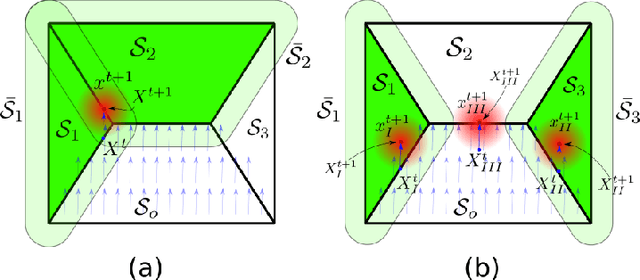
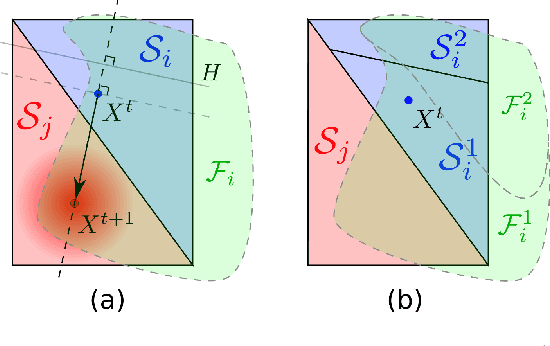
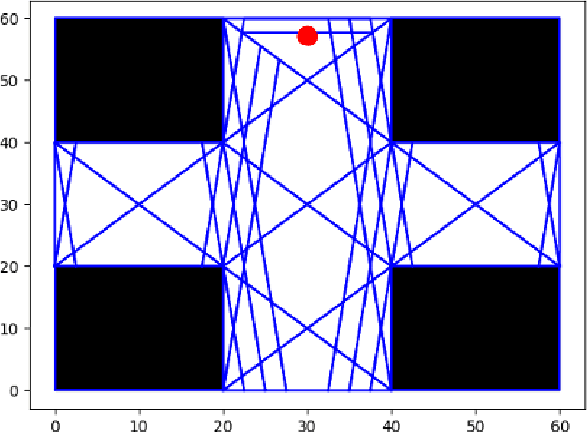
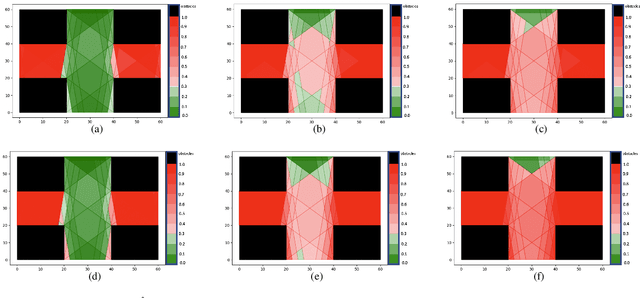
Abstract:In this work, we address the problem of formal safety verification for stochastic cyber-physical systems (CPS) equipped with ReLU neural network (NN) controllers. Our goal is to find the set of initial states from where, with a predetermined confidence, the system will not reach an unsafe configuration within a specified time horizon. Specifically, we consider discrete-time LTI systems with Gaussian noise, which we abstract by a suitable graph. Then, we formulate a Satisfiability Modulo Convex (SMC) problem to estimate upper bounds on the transition probabilities between nodes in the graph. Using this abstraction, we propose a method to compute tight bounds on the safety probabilities of nodes in this graph, despite possible over-approximations of the transition probabilities between these nodes. Additionally, using the proposed SMC formula, we devise a heuristic method to refine the abstraction of the system in order to further improve the estimated safety bounds. Finally, we corroborate the efficacy of the proposed method with simulation results considering a robot navigation example and comparison against a state-of-the-art verification scheme.
Temporal Logic Task Allocation in Heterogeneous Multi-Robot Systems
Jan 20, 2021



Abstract:In this paper, we consider the problem of optimally allocating tasks, expressed as global Linear Temporal Logic (LTL) specifications, to teams of heterogeneous mobile robots. The robots are classified in different types that capture their different capabilities, and each task may require robots of multiple types. The specific robots assigned to each task are immaterial, as long as they are of the desired type. Given a discrete workspace, our goal is to design paths, i.e., sequences of discrete states, for the robots so that the LTL specification is satisfied. To obtain a scalable solution to this complex temporal logic task allocation problem, we propose a hierarchical approach that first allocates specific robots to tasks using the information about the tasks contained in the Nondeterministic Buchi Automaton (NBA) that captures the LTL specification, and then designs low-level executable plans for the robots that respect the high-level assignment. Specifically, we first prune and relax the NBA by removing all negative atomic propositions. This step is motivated by "lazy collision checking" methods in robotics and allows to simplify the planning problem by checking constraint satisfaction only when needed. Then, we extract sequences of subtasks from the relaxed NBA along with their temporal orders, and formulate a Mixed Integer Linear Program (MILP) to allocate these subtasks to the robots. Finally, we define generalized multi-robot path planning problems to obtain low-level executable robot plans that satisfy both the high-level task allocation and the temporal constraints captured by the negative atomic propositions in the original NBA. We provide theoretical results showing completeness and soundness of our proposed method and present numerical simulations demonstrating that our method can generate robot paths with lower cost, considerably faster than existing methods.
Human-in-the-Loop Robot Planning with Non-Contextual Bandit Feedback
Nov 03, 2020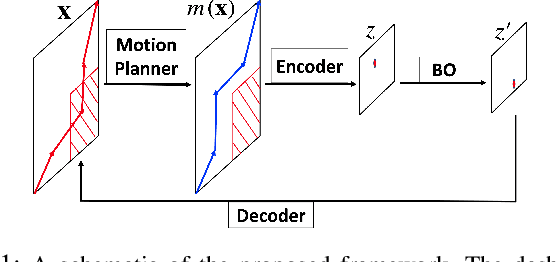
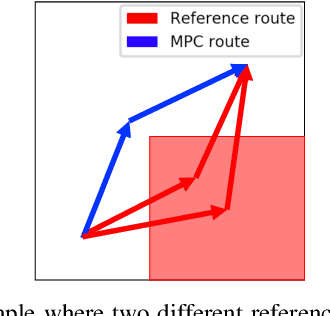
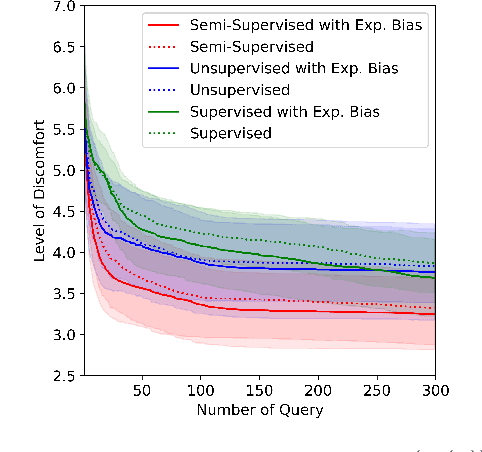
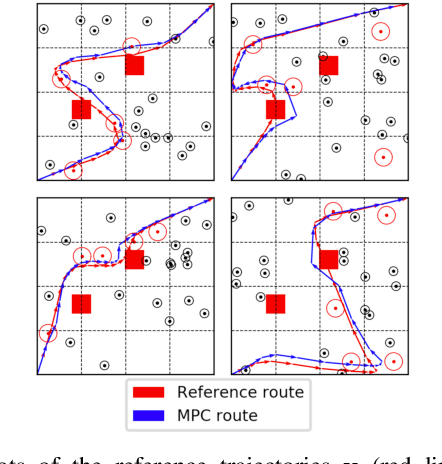
Abstract:In this paper, we consider a robot navigation problem in environments populated by humans. The goal is to determine collision-free and dynamically feasible trajectories that also maximize human satisfaction. This is because they may drive the robot close to humans that need help with their work or because they may keep the robot away from humans when it can interfere with human sight or work. In practice, human satisfaction is subjective and hard to describe mathematically. As a result, the planning problem we consider in this paper may lack important contextual information. To address this challenge, we propose a semi-supervised Bayesian Optimization (BO) method to design globally optimal robot trajectories using non-contextual bandit human feedback in the form of complaints or satisfaction ratings that express how satisfactory a trajectory is, without revealing the reason. Since trajectory planning is typically a high-dimensional optimization problem in the space of waypoints that define a trajectory, BO may require prohibitively many queries for human feedback to return a good solution. To this end, we use an autoencoder to reduce the high-dimensional problem space into a low dimensional latent space, which we update using human feedback. Moreover, we improve the exploration efficiency of BO by biasing the search for new trajectories towards dynamically feasible and collision-free trajectories obtained using off-the-shelf motion planners. We demonstrate the efficiency of our proposed trajectory planning method in a scenario with humans that have diversified and unknown demands.
 Add to Chrome
Add to Chrome Add to Firefox
Add to Firefox Add to Edge
Add to Edge